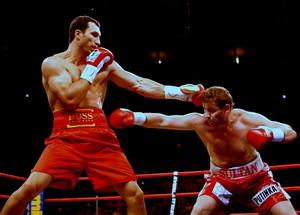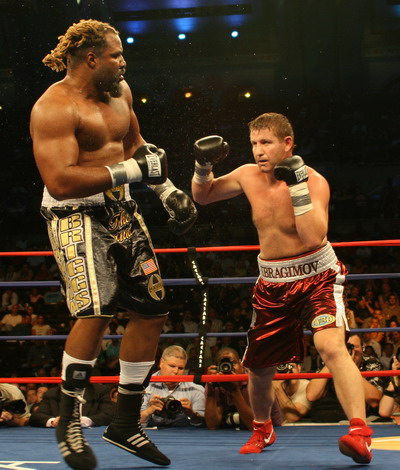 By Wray Edwards – Photos (c) Wray Edwards / ESB. I hadn’t given it much thought until watching the Ibragimov-Klitschko fight that perhaps it might be a good idea to consider a change in the divisional makeup of the upper weight ranges of Boxing. Now you’re thinking “Jeez aren’t things bad enough now with all the sanctions and divisions we have already?” Now just hold on…hear me out on this one. The lead photo in this article clearly shows what a mismatch looks like. It was the number one factor which ruined any chance for a competitive event at MSG last February (aside from the fact that Sultan’s team did not have a Plan B).
By Wray Edwards – Photos (c) Wray Edwards / ESB. I hadn’t given it much thought until watching the Ibragimov-Klitschko fight that perhaps it might be a good idea to consider a change in the divisional makeup of the upper weight ranges of Boxing. Now you’re thinking “Jeez aren’t things bad enough now with all the sanctions and divisions we have already?” Now just hold on…hear me out on this one. The lead photo in this article clearly shows what a mismatch looks like. It was the number one factor which ruined any chance for a competitive event at MSG last February (aside from the fact that Sultan’s team did not have a Plan B).
What might be done to reduce the likelihood of another such debacle?
First, we already have what is, essentially, the makings of a more appropriate range for a heavyweight division…it’s called the Cruiserweight division. I don’t know who came up with that title, but it sucks! How about this…Anybody fighting from 195 and up to say 225 -230 could logically be called a “heavyweight..” One point here regarding the lighter divisions…From straw weight to light heavy, a difference of five or ten pounds becomes less important as a percentage of total body weight. For a guy who weighs 100 lbs., 5 lbs. is roughly 5% and is significant. For a boxer who weighs 160 lbs 7 or 8 pounds is about 4% and is less significant.

The so-called Heavyweight division ranges from roughly 205 to ???…well, it’s unlimited. Does it make any sense that for the first one hundred pound range of boxer bodyweight there are seventeen!! divisions, while the next one hundred pound range has just one? Perhaps the Cruiserweight division should be scrapped and a heavyweight division from 195 to 225-230 would form a more manageable range for the first category of big guys. Of course there are many more candidates for the lower weight ranges, and it is easy to find fighters to pair up for contests. The higher we go in weight and size (some say into the freak range…to include Valuev, Big Show, Wlad and Vitali and several others) the fewer peer candidates are available. 225 to 250 might be called “super heavyweights” and above “unlimited.”
Then there are reach and height issues. Suppose some guy comes along in the future who weighs 225 and has a 90 inch reach…what do we do then? Valuev and the K-boys include this factor to a certain degree. There is a saying: “Physiology is destiny.” 5’5″ basketball players are rare because physical norms for the sport have gravitated towards seven feet. In Boxing, which is a contact sport, such differences are not allowed except in the so-called Heavyweight Division. But when a really big guy, who might otherwise be playing basketball or football, appears on the scene there are few who can come out to play with him. This has happened to the Heavyweight Division.
And though we cannot deny Wlad’s remarkable improvements in the technical and conditioning aspects of his participation, it is equally undeniable that he is “unfairly endowed” with physical attributes which give him a huge advantage against guys around 210-220 as he fights down from his physical peers in a thinly populated weight and size range.
What are we to do? Handicapping like in horseracing and golf? Restrictor plates? Obviously Wladimir is the perfect soma-type to be the greatest boxer of all time. Combine that with admirable technical and athletic skill and we have a problem. Should the six or seven guys on the planet who can measure up in these categories be restricted to an endless round-robin career with each other?
This subject also bears on the issue of weight shifting between weigh-in and fight night. The late Chico Corrales practically made an art-form of going from 130 to 144 between the scales and the fight. At that weight, it is a difference of nearly 11% and was a significant factor in some of his contests where his opponent was unable to match that mutation. Current practice tries to limit the hedge to 10%, but that still makes a mockery of the divisional rules. It is not unusual to have two boxers, one of whom is ostensibly a junior lightweight, fighting at lightweight, and the other fighter, also supposedly a junior lightweight, fighting in the mid range of the welter division.
Back in the day, before promoters had really discovered what promotional value could be gleaned from a weigh-in scheduled the day before a fight, boxers were required to step on the scales at ringside. That, of course, was the common sense, honest way to enforce divisional rules and preserve the authenticity of the sport’s bracketing system. Since then, more divisions have been added and a mish-mosh of sanctions have almost totally destroyed the credibility of the sport. (See my article on that subject in the archives under the title “The Weighting Game”.) Additionally, people always bring up dehydration as a factor in making weight. Nonsense! There are simple tests to ensure that boxers are not cheating in this way. More about that below.
The sport needs a retrofit asap, or it will continue to lose ground to MMA wrestling. Not that their divisions are necessarily better or that Dana White is a saint, but consolidated authority over championship credentials gives the fans a more dependable grid by which to enjoy their sport. Boxing’s mentors need to have a convention with Ring, WBO, IBF, WBC, IBO and Ted Kennedy (just for laughs) to revamp its entire structure, or they will all go down with the sport when it crashes to the point that HBO, ESPN and Showtime drop it altogether. If that does happen, and the sport ever comes back, it will once again be a single sanction, scales at ringside, properly divisioned sport.
BTW…the silly conventions regarding weight shifting between scales and ring should give way to a “walking around” factor if you will. The word “professional” should mean something. There are boxers who prove every day that they can stay in top shape all the time. Bernard Hopkins and many others through the heart of their careers are able to stay fit and avoid crash diets, diuretics and other gimmicks to make weight. The sanctions should require boxers who style themselves as “professional” prize fighters to stay in shape and fight regularly.
The minimum goal of such a convention should be to require mandatory contests between their top guys at least every six months as well as a minimum frequency requirement of at least two inter-divisional title fights per year by each champion with the other divisions’ guys. The goal would be to enforce the likelihood of unification and linear titles.
If a convention is not held, the sport will continue to spiral into an internecine jumble of avaricious sanctions ruled over by self-obsessed Major Domos protecting their pathetic little domains as HBO, Showtime and ESPN cluck their collective tongues in dismay.
Old Yank’s excellent survey of the sport’s equipment and temporal dynamics notwithstanding, if we continue to allow the sanction managers to dance on the heads of their separate little pins, we will not see the sport survive, let alone experience a resurgence. Boxing should not have to dream of a single great champion to restore its former glory. Only professional, highly organized, cooperative management by the sanctions can bring that about. Don’t hold your breath. See you at the fights.